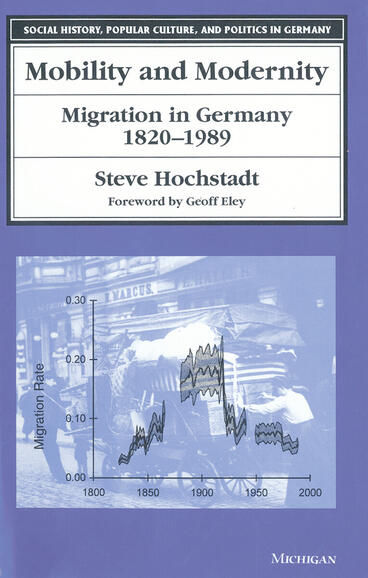Demonstrates that traditional beliefs about migration are really modern myths
Description
Mobility and Modernity uses voluminous German data on migrations over the past two centuries to demonstrate why conventional assumptions about the relationship between mobility and modernity must be revised.
Thus far the changing total volume of migration has not been traced over a long period for any country. Unique migration registration statistics, both detailed and broadly geographical in coverage, allow the precise plotting of migration rates in Germany since 1820. Steve Hochstadt combines careful quantitative methods, easily understood numerical data, and social analysis based upon broad reading in German social history to show that current beliefs about the direction and timing of changes in German mobility, which have been based on late nineteenth-century anxieties about urbanization and industrialization, do not match the data.
Migration rates in Germany rose continuously throughout the nineteenth century, and have fallen during the twentieth century. Mobility, Hochstadt argues, was not an unprecedented accompaniment to industrialization, but a traditional rural response to specific economic changes. Hochstadt's more precise analysis of urban in- and outmigration shows the mechanism of urbanization to have been the migration of families rather than the much greater, but also more circular, migration of single men and women.
Hochstadt demonstrates the importance of examining historical behavior, powerfully justifying the methods of historical demography as a path to social understanding. The data and specific conclusions are German, but the methods and reinterpretaion of migration history have much wider application, both to other modern European nations and to currently developing countries. Those who study the modern social history of Europe, the mechanisms that formed urban working classes, and the methods of historical demography will be interested in Hochstadt's work.
Steven Hochstadt was awarded the Social Science History Association's Allan Sharlin Memorial Award in 2000 for Mobility and Modernity. He is Associate Professor of History, Bates College.
Reviews
"Hochstadt argues persuasively that assumptions about migration patterns are at the core of important interpretive concepts in modern history such as urbanization, industrialization, and proletarianization. . . . The book must be read from cover to cover to mine the wealth of details, wide-ranging analyses, and extraordinary scholarship that are at the heart of this impressive sociodemographic study."
- Jean Quataert
--Jean Quataert, American Historical Review, October 2001
"His work will require a fundamental rethinking of German social history and should ultimately result in a more complex categorization that can capture the slow demographic and social transformation from peasant to urban worker. This work will become a classic in the field of mobility studies."
- D. J. Dietrich, Boston College
--D. J. Dietrich, Boston College, Choice, January 2000
". . . an excellent piece of scholarship . . . which, inter alia, pioneers the study of outmigration, establishes the temporary nature of most migration, limits the contribution of migration to urban growth and highlights the extent of mobility in the agricultural sector."
- John Perkins, University of New South Wales
--John Perkins, University of New South Wales, German History, Volume 18, No. 4 (2000)
"Hochstadt marshals impressive evidence to support his claim. . . vigorous and stimulating in his defense of the importance of the migration in social history. . . .Hochstadt has written a valuable work that should be read and pondered both by specialists in the history of Germany and of migration."
- William H. Hubbard
--William H. Hubbard, German Politics and Society, Volume 19, No. 2
"[Hochstadt] contributes to the ongoing revision of the pervasively held image that pre-industrial, peasant societies were sedentary, static, hidebound--in a word, Karl Marx's 'potatoes in a sack.' At every turn, Hochstadt challenges conventional wisdom. . . . This is an important work of scholarship that should be of value to anyone concerned with the nature of either 'mobility' or 'modernity.'"
- John Torpey, University of British Columbia
--John Torpey, University of British Columbia , Journal of Interdisciplinary History, Autumn 2000
"Hochstadt has written what will long remain the definitive work on German urban migration and population turnover. . . . His work has important implications for scholars far beyond this narrow genre, indeed, for social history in general."
- Walter D. Kamphoefner
--Walter D. Kamphoefner, Journal of Social History, Summer 2001

